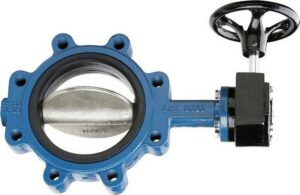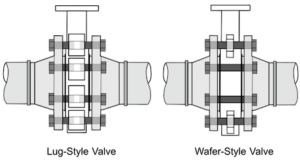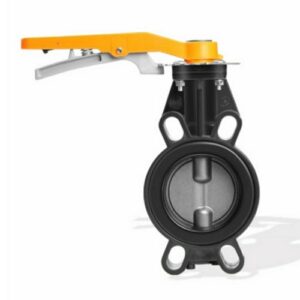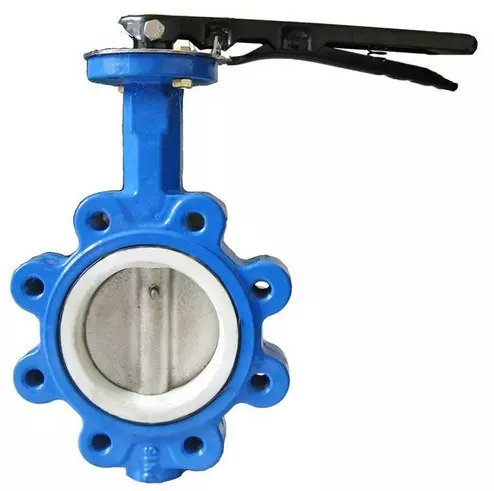In this article from Linquip, we will talk about Different Parts of Butterfly Valve. These useful valves are utilized for isolating and regulating the flow of a liquid. Butterfly valves are considered to be among the quarter-turn valves and their working principle are the same as ball valves. These valves are quick to act and with just a quarter turn, can move from fully open to fully closed position. Now that you know a bit more about these valves, let’s dive deeper and learn about different parts of butterfly valve.

⇒ View a List of Butterfly Valves for Sale and Their Suppliers ⇐
Different Parts of Butterfly Valve
Before moving forward, let’s first take a quick look at 6 Different Parts of Butterfly Valve all at once:
- Butterfly Valve Body: (The wafer-style body, Lug style butterfly valves)
- Disk
- Stem: Wetted, Non-wetted
- Seat
Based on the actuation method, there can be some other parts as well, including:
- Hand Lever
- Gear
For the automatic actuation, the parts are a bit different based on the butterfly valve type. These types that contain automatic actuation are Electric, Pneumatic, and Hydraulic.
The parts mentioned above are the necessary units of a butterfly valve. Now we will explain them one by one to understand their function better. Each of these parts plays an important role in the final purpose of the butterfly valve. For example, the disc is placed at the core of the pipe and a rod runs through this disc and reaches an actuator that is positioned on the outside of the valve. By the rotation of the actuator, the disc starts to move. This movement can be perpendicular or parallel to the flow of the fluid.

Butterfly Valve Body
The body contains different parts of butterfly valve. Bodies fit between two pipe flanges and they have two common designs: wafer-style body and lug style butterfly valve.
- The Wafer-Style Body
This design uses bolt holes that run through the body of the valve for connecting to the pipes. The wafer-style body is more economical than the lug style butterfly valve because the design is a bit less complex and it is easier to install. They are mainly used in universal flow systems in order to avoid backflow. Keep in mind that they are not suitable for regulated systems.
- Lug Style Butterfly Valves
This design uses protruding lug holes that are placed on the outside of the body of the valve for connecting to the pipe. Due to their complex design, they are a bit more expensive compared to wafer-style body design. However, they have different advantages that justify the cost. The valve in lug style butterfly valve has been designed in a way that helps carry the weight of piping inside the body which is a great plus point compared to its competitor. When piping from one side of the valve is removed, you will have dead-end servicing available.
Disk
Among different parts of butterfly valve, a disk exists that has been positioned inside the body of the butterfly valve. This disk is responsible to control the flow of the fluid and works similar to the gates or balls that are placed inside the ball valves. The disk also has two types: Eccentric and Concentric. The eccentric disc has a bit more complicated design compared to the concentric. The concentric disk contains a stem that passes through the disk’s centerline. Valves with concentric disks are usually used in applications that require low pressure. The eccentric disk, in contrast, contains a stem that runs behind the center line. It is in the opposite flow direction.
The eccentric disk is among the parts of butterfly valve that has been initially designed to help prevent the contact between the seal and the disk before the butterfly valve is closed completely. This design enables the valve to have a longer lifespan.
Stem
Although the stem is a very small item when compared to other parts of butterfly valve, it is crucial for the function of the valve. The stem is used for connecting the disk inside the valve to the handle that is positioned on the outside. It enables the butterfly valve to open or close.
Stems are available with two different designs related to the protection of the stem:
- Wetted
Wetted stems are vulnerable to corrosion and erosion and don’t contain materials in their design to protect them from such problems. That is why it should be made of materials that are compatible with the media that are going to flow through the line.
- Non-Wetted
This stem has been designed in a way that is protected from erosive or corrosive liquids that are running in the line.
Seat
Last but not least in the list of different parts of butterfly valve is the seat. Seats are usually made from various polymers and are either pressed or locked down or bonded to the body. The use of polymer is to increase the leak-proof ability of the seal between the seat and the disk. By pressing the disk against the seat, these two will seal together. This will stop the flow. It’s interesting to know that the seat runs the length of the inner diameter of the butterfly valve.
Now, this is where the actuation method comes into play. Butterfly valves can be controlled manually or automatically depending on the design. If they are manual, they have handles and gears. If they are automatic, they contain pneumatic, electric, or hydraulic actuators. Now, we’ll explain the remaining parts of butterfly valve that are related to these specific types of designs.
Hand Lever
These parts are usually made from steel and they are chemically treated and powder coated to pass meticulous inspection/salt spray tests for dimensional accuracy. Hand levers commonly contain a handle and a locking lever. Plus, they are normally used for small butterfly valves. These hand levers can be locked into different positions including closed, open, and partially open.

Gear
Another item in the list of different parts of butterfly valve for the manually operated ones is the gear. They are used for larger butterfly valves. The use of a gearbox increases the torque but slows the opening and closing speed as a result. The butterfly valves that use gears are self-locking and can’t be back driven. But they may have position indicators.
That was all there is to know about different parts of butterfly valve. What do you think about them? Which part do you think is the most crucial one? Which one do you think has room for improvement? Comment below and share your thoughts with us. Don’t forget to sign up on Linquip to talk to our experts if you have any questions about this field. Linquip is always here to answer all your questions and solve your problems.
Buy Equipment or Ask for a Service
By using Linquip RFQ Service, you can expect to receive quotations from various suppliers across multiple industries and regions.
Click Here to Request a Quotation From Suppliers and Service Providers
Read More on Linquip
- What is a Butterfly Valve? Working Principle & Function
- Gate Valve vs Butterfly Valve: Comprehensive Guide in 2022
- Main Parts of Gate Valve: Practical Guide in 2022
- Different Parts of Check Valve with Diagram
- Parts of Sprinkler Valve: Diagram & Replacement Parts
- Parts of Shower Valve: Name & Diagram
- Butterfly Valve Installation Costs and Maintenance in 2022
- Top Manufacturers and Suppliers of Butterfly Valves
- Globe valve parts 101: All you need to know in one place
- Ball Valve Parts: An Easy-to-Understand Guide (2022 Updated)
- Control Valve Parts: The Go-To Guide for beginners and experts
- Backwater Valves Installation, Costs and Maintenance in 2022
- How to Repair a Gate Valve? (Clear Guide)
- Backflow Valve Installation, Costs and Maintenance in 2022
- How to Install a Thermostatic Mixing Valve? (Costs and Maintenance in 2022)
- How to Install a Water Pressure Reducing Valve? (Costs and Maintenance in 2022)
- Check Valve Installation Costs and Maintenance in 2022
- The 10 Best Water Shut off Valves of 2022
- What is Drain Valve? Working Principle, Types & Applications
- What are Coaxial Valves? Working Principles and Type
- What is Isolation Valve? Working Principle & Types
- Backwater Valves: Working Principles & Types
- What is Block Valve? Working Principle & Types




Very insightful article
Thanks for visiting our website, Rajesh! We also encourage you to visit the Linquip website, where you can find numerous industrial equipment, along with companies and experts.
Such an informative blog. Keep sharing this type of blog.
Thanks for visiting our website and leaving your comment! We hope to hear from you again in our other posts.
I’m looking for 4″ 6″ 8″ 10″ 12″ fully lugged butterfly valves
Regards
Solomon sanyamandwe
Thanks for visiting our website. You can visit our Industrial Equipment page, where you can find various butterfly valvess based on your application and demand. You can also visit our expert page and take advice from hundreds of professionals on your issue.